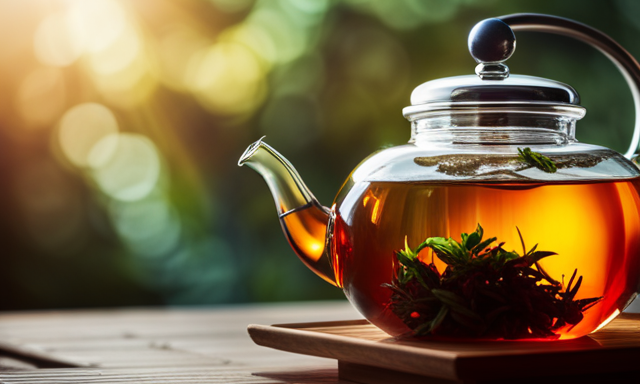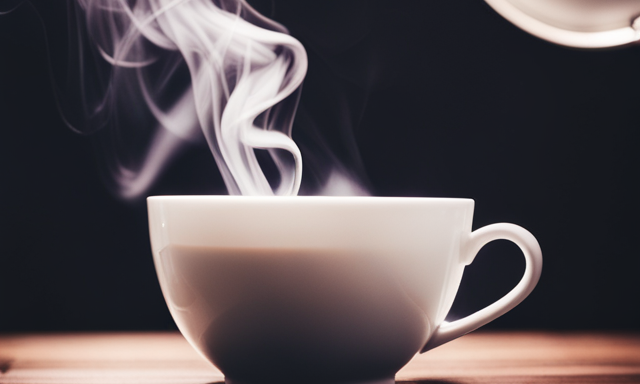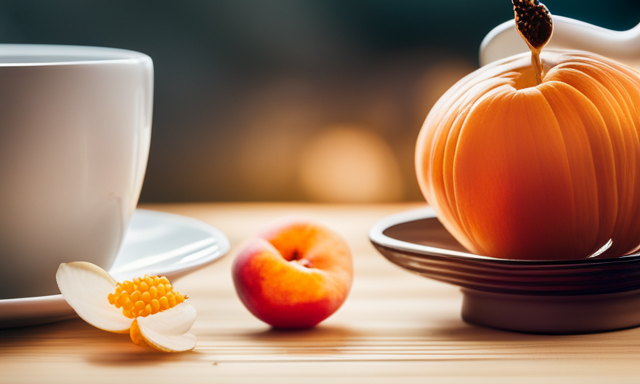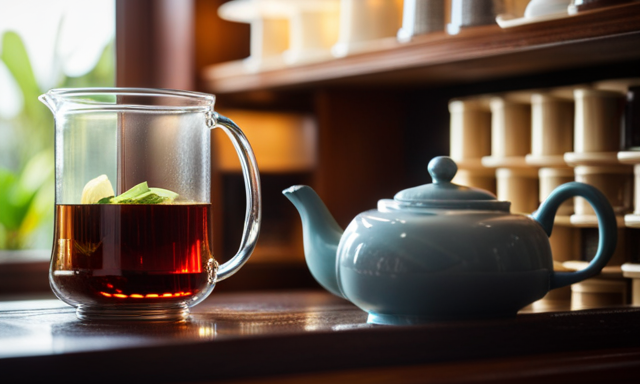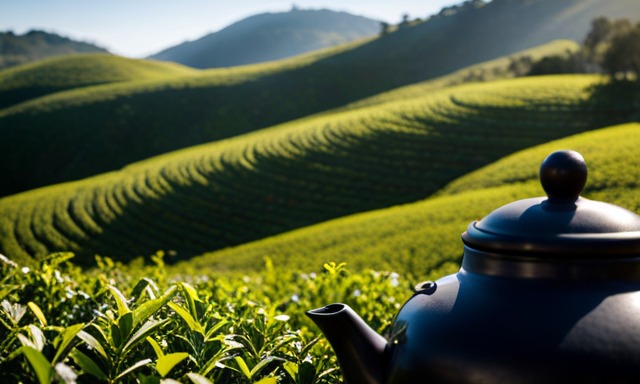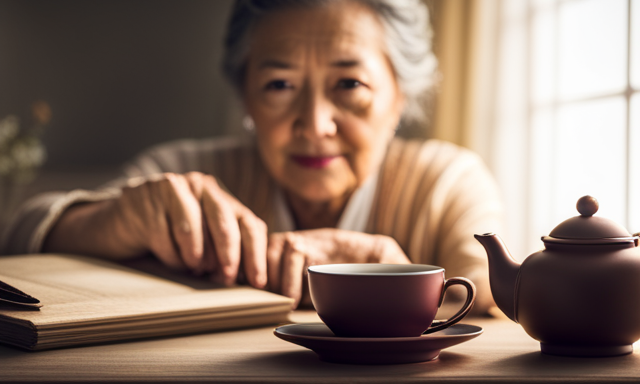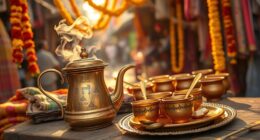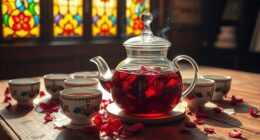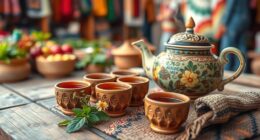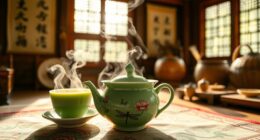As a tea enthusiast, I have always been intrigued by the rich flavors and aromas that different types of tea can offer. One particular variety that has captivated my taste buds is oolong tea. With its unique combination of oxidation levels, oolong tea strikes a perfect balance between the boldness of black tea and the delicacy of green tea.
In this article, I will guide you through the fascinating journey of oolong tea, from its origins to its cultural significance in modern society. You will learn how to choose and store the finest oolong tea, as well as the art of brewing and serving it to enhance your tea-drinking experience. Whether you are a seasoned tea connoisseur or a beginner curious to explore the world of oolong tea, this article will provide you with all the knowledge and tips you need to enjoy this exquisite beverage to the fullest.
So, let’s dive into the enchanting world of oolong tea together!
Key Takeaways
- Oolong tea is its own distinct category, not a blend of green or black tea.
- Oolong tea offers a wide range of flavors and aromas, including floral, fruity, toasty, and earthy notes.
- There are various oolong tea varieties, each with its own characteristics, such as Tie Guan Yin (light and delicate) and Da Hong Pao (rich and robust).
- Exploring oolong tea is a worthwhile journey due to its unique production process and the different brewing methods available.
What is Oolong Tea?
Oolong tea, often referred to as the ‘champagne of teas,’ is a delightful and fragrant beverage that strikes the perfect balance between the richness of black tea and the freshness of green tea. Originating from China, this unique tea has a long and fascinating history.
It is said that oolong tea was first produced during the Ming Dynasty and gained popularity during the Qing Dynasty. Today, oolong tea is not only enjoyed in China but also in various other countries around the world.
There are different types of oolong tea, each with its own distinct characteristics. Some well-known varieties include Tie Guan Yin, Da Hong Pao, and Oriental Beauty. These teas vary in flavor, aroma, and appearance, offering a wide range of options for tea enthusiasts to explore.
Moving on to the health benefits of oolong tea…
Health Benefits of Oolong Tea
Experience the amazing health benefits of this perfectly balanced beverage by incorporating it into your daily routine. Oolong tea has been praised for its numerous health benefits, supported by scientific research.
It’s rich in antioxidants, which help to combat free radicals and reduce oxidative stress in the body. These antioxidants also contribute to improved heart health by reducing cholesterol levels and promoting healthy blood pressure.
Oolong tea has been shown to aid in weight management by boosting metabolism and promoting fat oxidation. Additionally, it may help regulate blood sugar levels and improve insulin sensitivity, making it beneficial for individuals with diabetes.
The combination of caffeine and other compounds in oolong tea can enhance mental alertness and improve brain function. So, start enjoying the health benefits of oolong tea today!
Now, let’s move on to how to choose and store oolong tea.
How to Choose and Store Oolong Tea
Indulge in the art of selecting and preserving your preferred variety of this exquisite infusion. When it comes to choosing and storing oolong tea, there are a few important factors to consider.
First, consider the flavor profile you prefer. Oolong tea can range from light and floral to dark and roasted, so take your time exploring different varieties to find the one that suits your taste.
Once you’ve chosen your oolong tea, it’s crucial to store it properly to maintain its freshness and flavor. Store your oolong tea in an airtight container in a cool, dark place away from strong odors. This will ensure that it stays fresh for longer.
Now that you know how to steep oolong tea and understand its flavor profiles, let’s move on to the next section about brewing oolong tea.
Brewing Oolong Tea
Once you’ve chosen your preferred variety, it’s essential to brew this exquisite infusion correctly to fully savor its unique flavors and aromas.
Brewing oolong tea requires precise techniques to bring out its delicate taste. Start by heating water to around 190-200°F, as using boiling water can result in a bitter brew.
Add the desired amount of loose oolong tea leaves to a teapot and pour the hot water over them. Let it steep for about 3-5 minutes, allowing the leaves to unfurl and release their flavors. The color of the steeped tea should range from pale yellow to amber, depending on the oxidation level.
The brewing time can be adjusted according to personal preference, with longer steeping times producing stronger flavors. Once brewed, the fragrant oolong tea is ready to be served and enjoyed, revealing its complex and enticing taste profile.
Moving on to the next section about serving and enjoying oolong tea, let’s explore the various ways to enhance this exceptional beverage.
Serving and Enjoying Oolong Tea
To fully enjoy the captivating flavors of your perfectly brewed oolong tea, savor it like a warm embrace on a chilly winter evening. When it comes to serving techniques, it’s essential to remember that oolong tea is best enjoyed in small cups to fully appreciate its exquisite taste.
The aroma of the tea can be enhanced by gently swirling the cup before taking a sip. As for tea pairing, oolong tea pairs excellently with light and delicate foods like steamed dumplings or fresh seafood. The subtle floral and fruity notes of the tea complement the flavors of these dishes beautifully.
Now, let’s delve into the cultural significance of oolong tea and discover its rich history and traditions.
Oolong Tea and its Cultural Significance
Immerse yourself in the rich cultural tapestry surrounding oolong tea as you explore its historical significance and the traditions woven into its essence. Oolong tea is not just a beverage but a representation of cultural traditions passed down through generations.
The art of serving oolong tea is steeped in cultural significance. From the elegant tea sets to the precise brewing techniques, every aspect of the process is carefully crafted to create a harmonious experience.
Oolong tea ceremonies are cherished traditions in many Asian cultures. These ceremonies are a way to honor the tea and create a sense of mindfulness and tranquility.
Each step of the tea ceremony is imbued with meaning, from the washing of the teaware to the pouring of the tea. It is a time to appreciate the beauty of the tea and connect with oneself and others.
As we delve into oolong tea in modern society, we will see how these cultural traditions have shaped the way we enjoy this beloved drink.
Oolong Tea in Modern Society
Explore how oolong tea has seamlessly integrated into modern society, revealing its adaptability and popularity among tea enthusiasts. Oolong tea has not only captivated taste buds but has also made its mark in the realm of mental health. Its rich and complex flavors provide a calming and soothing effect, promoting relaxation and reducing stress.
Additionally, oolong tea has been recognized for its potential role in weight management. Its combination of caffeine and catechins helps boost metabolism and promote fat oxidation, making it a favorite among those seeking a natural way to shed pounds.
As we delve into the world of oolong tea for beginners, it’s important to understand the various types and brewing methods that will enhance your tea-drinking experience.
Oolong Tea for Beginners
Indulging in the flavorful world of oolong tea is like embarking on a captivating journey of aromatic discovery. Oolong tea offers a wide range of flavor profiles, from floral and fruity to toasty and nutty. To fully appreciate these nuances, it is essential to understand the proper brewing techniques. The key is finding the right balance between water temperature and steeping time. Generally, oolong tea should be brewed at a temperature of 180-200°F for 3-5 minutes. This allows the leaves to unfurl and release their rich flavors. Steeping oolong tea for too long can result in a bitter taste, while steeping it for too short may result in a weak flavor. With these brewing techniques in mind, you can create a perfect cup of oolong tea every time. Moving on to the frequently asked questions about oolong tea…
Frequently Asked Questions about Oolong Tea
Now that we’ve covered the basics of Oolong Tea for beginners, let’s address some frequently asked questions about this fascinating beverage.
As a tea enthusiast myself, I’ve encountered a few common myths surrounding oolong tea that I’d like to debunk. Contrary to popular belief, oolong tea isn’t just a green or black tea blend; it falls into its own distinct category.
With its unique production process, oolong tea offers a wide range of flavors and aromas, from floral and fruity to toasty and earthy. Additionally, there are various oolong tea varieties, each with its own characteristics and brewing methods.
From the light and delicate Tie Guan Yin to the rich and robust Da Hong Pao, exploring the world of oolong tea is truly a journey worth embarking on.
Frequently Asked Questions
Is oolong tea suitable for people with caffeine sensitivity?
Oolong tea is suitable for people with caffeine sensitivity because it contains less caffeine than black tea or coffee. Additionally, oolong tea has been shown to aid in weight loss and promote healthy skin due to its high levels of antioxidants.
Can I add milk or sugar to oolong tea?
Yes, you can add milk to oolong tea for a creamy touch. However, adding sugar is a matter of personal preference. It can enhance the flavor and sweeten the tea, but be mindful of its potential impact on your health.
How long does oolong tea stay fresh after opening the package?
Oolong tea stays fresh for about 6-12 months after opening the package if stored properly. To store it correctly, keep it in an airtight container away from light, moisture, and strong odors. Make sure to check the expiration date as well.
Does oolong tea have any side effects?
Oolong tea has numerous potential health benefits and is generally safe to consume. However, excessive intake may lead to side effects such as caffeine sensitivity or digestive problems. It is recommended to limit daily intake to a moderate amount.
Can I reuse oolong tea leaves for multiple infusions?
Yes, you can reuse oolong tea leaves for multiple infusions. Did you know that reusing tea leaves can actually enhance the flavor and aroma? It’s a great way to get the most out of your tea and enjoy its benefits to the fullest.
Conclusion
In conclusion, I’ve shared with you the wonders of oolong tea and how to make and enjoy it. It’s fascinating to see the cultural significance of this beverage and how it has become a beloved part of modern society.
With its numerous health benefits and unique flavors, oolong tea truly stands out. So, next time you’re in need of a soothing, aromatic drink, reach for oolong tea and let its delicate yet robust flavors transport you to a world of relaxation and wellness.
Cheers to the art of oolong tea!

